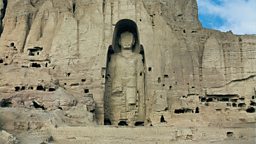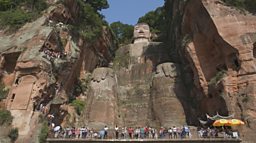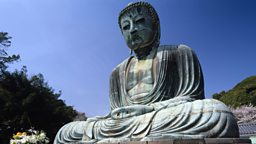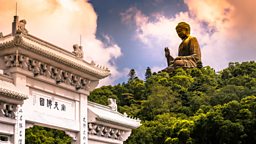Main content
Images of the Buddha
Significant anthropomorphic images of the Buddha began to emerge in Northern India in the first century AD, some 600 years after lived and died.
From the end of the 1st century AD, images of Buddha in human form began to proliferate.
The images which follow show depictions of the Buddha - both ancient and modern - in sculpture and painting, from some of the countries where Buddhism took hold.
Thailand: The Emerald Buddha

The Emerald Buddha presides over the Wat Phra Kaew Temple in Bangkok - the most sacred Buddhist site in Thailand. Legend has it that the small (26-inch) jade statue was made in India in 43 BC, before being taken to Sri Lanka in the 4th century AD, then on to Wat Phra Kaew in 1779. Only the King of Thailand may touch the statue - its three sets of gold clothing, reflecting the progress of the seasons, are changed during the year by the King.
Afghanistan: The Buddhas of Bamyan

Afghanistan: the famous Buddhas of Bamyan were carved out of sandstone cliffs in the Hazarajat region of Afghanistan, in the 6th century AD. In 2001 they were declared to be 'idols' by the then Taliban government of Afghanistan, and destroyed. Photo: Getty Images/De Agostini
China: The Giant Buddha of Leshan

China, Sichuan Province, Leshan: the largest Buddha in the world (built to protect fishermen in the Dadu river below) was begun in 713 AD by a Buddhist monk, and was completed 90 years after his death. Photo: Getty Images/John W Banagan
Japan: The Great Buddha of Kamakura

Japan, Kamakura Prefecture: the Great Buddha ('Daibutsu') is one of Japan's most celebrated Buddhist figures. The 40-foot bronze statue, weighing 93 tons, is located in the K艒toku-in Temple, and was erected in the 12th Century AD. Photo: Getty Images/huayang
Hong Kong: Tian Tan Buddha

Hong Kong, Lantau Island: the Tian Tan Buddha, also known as the 'Big Buddha' is a 112-foot, 280-ton bronze statue, completed in 1993. It symbolises the harmonious relationship between man and nature, people and faith. Photo: Getty Images/Anuchit Kamsongmueang
Burma: The Buddhas of Monywa

The Burmese city of Monywa boasts what is currently the largest of the world's reclining Buddhas. The reclining figure represents Buddha during his last illness, before passing into the state of 'nirvana-after-death', and is one of the most widespread and potent Buddhist iconic symbols. The Burmese figure, built in 1991, is 300 feet in length, the head 60 feet high. Inside the hollow construction are 9,000 one-foot-high metal images of the Buddha and his disciples, depicting various representations of important events in the Buddha鈥檚 life. Adjacent to it is a 433-foot standing Buddha, one of the largest in the world. The Burmese reclining Buddha may soon be surpassed in size by a new construction in China.
Tibet: Jokhang Temple, Lhasa

Tibet, Jokhang Temple, Potala Palace, Lhasa: throughout history, the Buddha has been depicted in graphic art as well as statuary. This exquisite wall painting is displayed in one of the most important temples in Tibet. Getty Images/Jon Bower
